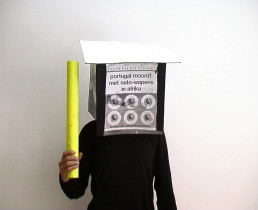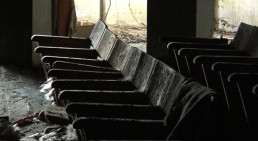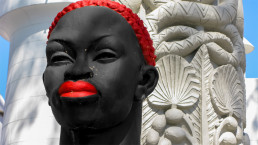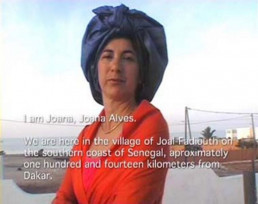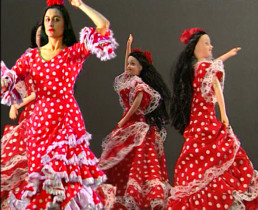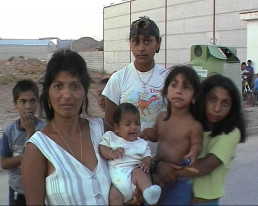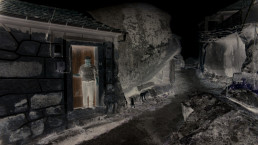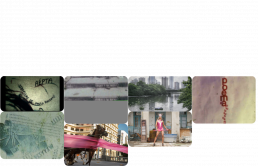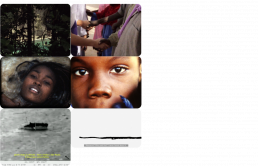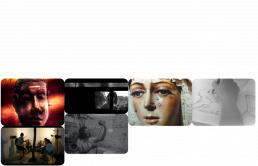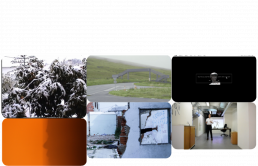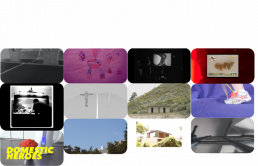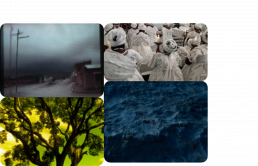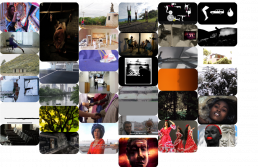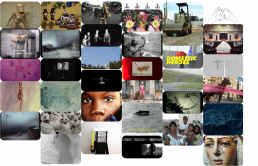“FUSO 2017 – 22 a 27 de Agosto“
25 Agosto, 23h15
Museu Nacional de Arte Antiga (MNAA)
A classe dos povos extintos
Curadoria de Emília Tavares
Duração da sessão 62’
Em 1869, Antero de Quental analisava Portugal como pertencendo a uma classe de povos extintos, referindo que o dogma da nacionalidade fora forjado contra o federalismo e as identidades diversas, defendendo por isso um iberismo espiritual como garantia de uma vivência verdadeiramente democrática e popular.
A utopia da geração dos Vencidos da Vida, deu lugar ao dealbar de um novo século em que Portugal expulsou o melhor da sua cultura e arte, para impor um obscurantismo de repercussões muito longas. Por seu lado, o recente colapso de uma Europa plural e solidária, redireciona também a geoestratégia dos sonhos coletivos, e obriga-nos a resgatar da história algumas das suas mais ambiciosas utopias.
Com base neste horizonte histórico, foi elaborado um programa para estabelecer o encontro entre artistas portugueses e espanhóis que, através da sua obra, têm observado e trabalhado as respetivas Histórias, no seu papel de edificação de discursos de poder e de identidade nacional.
As obras apresentadas questionam alguns dos fundamentos políticos dessa identidade, bem como a sua legitimação histórica, através de mecanismos dogmáticos. Elaboram também observações contundentes sobre a génese cultural e identitária, a pesada herança dos impérios, os estereótipos do Sul ou as dissensões e traumas de cada um dos países perante a sua memória coletiva; constituindo dessa forma obras que interpelam não só o devir histórico, como o presente, nos seus processos de normalização e massificação. Assim reunidas, estas obras evocam uma comunhão de interesses e de inconformidade, unem, por via da arte, a mesma procura de uma sociedade mais justa, crítica e informada. Desfazem, por isso, as diferenças politicamente construídas, e podem estabelecer novos diálogos.
Emília Tavares, 2017
Pedro Barateiro, Identidade em Construção, 2006, 1’45’’
Identidade em Construção é uma obra feita a partir de imagens recolhidas da história recente de Portugal, em particular do processo de descolonização. O vídeo pretende questionar a construção de identidade através da interpretação e análise de imagens da história do país. A figura humana é representada enquanto edifício e escultura, capaz de incorporar e reter referências.
Maria Ruído, Lo que no puede ser visto debe ser mostrado, 2010, 12’
O que não pode ser visto… é um documentário sobre a memória da Transição Espanhola construída a partir de certas produções de cinema militante, que contradiz as imagens oficiais que elaboraram a memória do fim do regime de Franco e o início da democracia Espanhola.
“Desde o dever da memória”, nas palavras de Primo Levi, Maria Ruído aborda a construção da memória histórica do estado espanhol, mas a sua aproximação não é baseada em testemunhos gravados, mas na constatação da falta de imagens sobre determinados acontecimentos ou problemáticas.
Produção Producciones Doradas (Magazine Doropedia)
Edição Iván Gómez
Com fragmentos de Plan Rosebud (2008) de María Ruido, Rocío (1980) de Fernando Ruiz Vergara, Margarita y el lobo (1969) de Cecilia Bartolomé, No-Do (Noticiario Documental), O todos o ninguno (1975-76) de Helena Lumbreras e Mariano Lisa, La Transición española (1993) de Victoria Prego, Arquivos da TVG e TVE, e arquivo pessoal de Angel Santos
Vozes Jo Labanyi, Cecilia Bartolomé, Jorge Luis Marzo, Mariano Lisan, Carme Moliner
Vasco Araújo, Parque Temático, 2016, 8’44’’
Partindo da iconografia colonial existente no Portugal dos Pequenitos, protagonizada pelas esculturas que se encontram à entrada dos pavilhões das antigas colónias portuguesas, Parque Temático aborda os problemas da existência e da liberdade do homem. Ao tratar, também, as lógicas por detrás das relações de poder vigentes durante o colonialismo e o pós-colonialismo, mostra-nos o perverso jogo de submissão construído a partir da história da escravatura e segregação congelada na estatuária que representa figuras de negros para sempre presos nessa condição.
Vozes Sofia Lobo, João Pedro Gama, Igor Lebreaud, Miguel Magalhães, Ana Pires Quintais, Delfim Sardo, Vasco Araújo
Texto Vasco Araújo
Música Quartetto per Archi Nº1 e Threnody for the Victims of Hiroshima for 52 Stringed Instruments, de Krzysztof Penderecki
Ângela Ferreira, Joal la Portugaise, 2004, 6’15’’
“De tudo aquilo que me contaram, o que mais chamou a minha atenção foi o que me disseram sobre a origem do nome de Joal. Existem várias versões. Para alguns, este nome vem do Serere “Joong”, que significa “pequena altitude”: teria permitido designar a aldeia em que uma parte se elevava relativamente ao resto da paisagem. Segundo uma outra etimologia, a que me interessa mais, Joal provinha do nome de Joana Albiz, mulher ou irmã de um navegador português. Claro que nada disto pode ser provado. O interessante, para mim, é que esta história se transmitiu oralmente através dos séculos e que este relato inacabado deu a pessoas como Senghor a possibilidade de lhe associar elementos novos. Pelo meu lado, tomei a liberdade de desenvolver um pouco esta história: numa série de performances, tornei-me Joana Albiz, tentei dar corpo a essa personagem, imaginar as razões da sua vinda para Joal. Talvez ela nunca tenha existido na realidade, mas interrogarmo-nos sobre a razão da sua vinda é simbólico; é perguntar o porquê da vinda do colonialismo para África.”
Pilar Albarracín, Musical Dancing Spanish Dolls, 2001, 3’25’’
As intervenções, ações e performances e também alguns dos vídeo-performances e séries fotográficas de Pilar Albarracín tendem a surpreender pelo seu aspeto decididamente teatral. Por trás desta artificialidade exagerada esconde-se, porém, uma autêntica paixão: a de produzir contra-espetáculos. Utilizando a estratégia da camuflagem e aproveitando os seus dotes de intérprete e o seu talento para criar cenografias, a artista consegue, por fim, confundir e, com um pouco de sorte, provocar dúvidas sobre a autenticidade desses espetáculos que pretendem representar a realidade.
Cortesia da artista, Galerie Vallois, Paris e Galeria Filomena Soares, Lisboa
Valeriano López, Me duele el chocho, 2002, 3’34’’
Corre um rumor pelo bairro que veio um não-cigano com dor de Espanha. Este é o texto de abertura do vídeo e o seu realizador é o não-cigano que busca a colaboração de uma comunidade cigana, convidando-os a dizer, em frente à câmara, a famosa frase do escritor Miguel de Unamuno – “Me duele España” – que resume o espírito ilustrado e cético da geração de 98. Mas o humor transgressor dos protagonistas transfere o sentimento Unamunoiano da esfera pública para a pessoal, enunciando a frase que dá título ao vídeo e que move o núcleo do problema de Espanha para o centro corporal da sua comunidade.
Mauro Cerqueira, Leonel, 2015, 3’06’’
Leonel é um vizinho do artista Mauro Cerqueira, um toxicodependente que ganha a vida a roubar e a revender tralha durante o dia. Cerqueira filma a errância de Leonel pela cidade do Porto, pelas ruas e lugares de um mundo e de uma vida à margem, aproximando-nos dum universo de objetos, ações, memórias, encontros e desacordos que pertencem à sua vida e imaginário. Uma vida que, nesta versão mais curta do filme, conjuga uma alegoria da fuga para países longínquos com a morte da esperança.
Lois Patiño, Noite sem distância, 2015, 23’
Um instante na memória da paisagem: o contrabando que durante séculos cruzou a linha entre Portugal e a Galiza. As montanhas do Gerês não conhecem fronteiras, e as rochas atravessam um país ao outro com insolência. Os contrabandistas também desobedecem a essa separação. As rochas, o rio, as árvores – testemunhas silenciosas, ajudam a esconder. Eles só precisam de esperar pela noite para cruzar a distância que os separa.
“FUSO 2017 – August 22 to 27“
August 25, 11:15pm
Museu Nacional de Arte Antiga (MNAA)
The Class of the Extinct People
Curatorship by Emília Tavares
Total running time 62’
In 1869, Antero de Quental analysed Portugal as belonging to a class of extinct peoples, stating that the dogma of nationality was forged against federalism and multiple identities, thus defending a spiritual Iberism as a guarantee of a truly democratic and popular experience.
The utopia of the Vencidos da Vida generation gave way to the dawn of a new century in which Portugal expelled the best of its art and culture to impose obscurantism with very long repercussions. For its part, the recent collapse of an Europe of plurality and solidarity also redirects the geostrategy of collective dreams and compels us to rescue from history some of its most ambitious utopias.
Based on this historical horizon, a program was drawn up to establish an encounter between Portuguese and Spanish artists who, through their work, have observed and worked on their respective Histories, in their role of building discourses of power and national identity.
The works presented question some of the political foundations of this identity, as well as its historical legitimation through dogmatic mechanisms. They also elaborate observations on the cultural and identity genesis, the heavy inheritance of the empires, the stereotypes of the South and the dissensions and traumas of each of the countries before their collective memory; Thus constituting works that address not only the historical becoming, but also the present, in their processes of normalization and massification.
Together, these works evoke a communion of interests and nonconformity; they unite, through art, the same demand for a more fair, critical and informed society. They undo, therefore, the politically constructed differences, and can establish new dialogues.
Emília Tavares, 2017
Pedro Barateiro, Identidade em Construção (Identity Under Construction), 2006, 1’45’’
Identity Under Construction is a work made from images collected from the recent history of Portugal, in particular that of the decolonization process. The video intends to question the construction of identity through the interpretation and analysis of images of the country’s own history. The human figure is represented as building and sculpture, capable of incorporating and retaining references.
Maria Ruído, Lo que no puede ser visto debe ser mostrado, 2010, 12’
What cannot be seen… is a documentary about the memory of the Spanish Transition built from certain productions of militant cinema, which contradict the official images that have elaborated the memory of Franco’s regime and the beginning of Spanish democracy.
“From the duty of memory”, in the words of Primo Levi, María Ruído addresses the construction of the historical memory of the Spanish state, but its approximation is not based on recorded testimonies, but on the acknowledgement of the lack of “antagonist images” or public debates about the Spanish democracy.
Production Producciones Doradas (Magazine Doropedia)
Editing Iván Gómez
With fragments of Plan Rosebud (2008) by María Ruido, Rocío (1980) by Fernando Ruiz Vergara, Margarita y el lobo (1969) by Cecilia Bartolomé, No-Do (Noticiario Documental), O todos o ninguno (1975-76) by Helena Lumbreras and Mariano Lisa, La Transición española (1993) by Victoria Prego, TVG and TVE archives, and personal archive of Angel Santos
Voices Jo Labanyi, Cecilia Bartolomé, Jorge Luis Marzo, Mariano Lisa and Carme Moliner
Vasco Araújo, Parque Temático, 2016, 8’44’’
Exploring the colonial iconography on display at Portugal dos Pequenitos theme park (lit. Portugal for the Little Ones), spearheaded by the sculptures standing at the entry to the pavilions representing the former (Portuguese) colonies, Parque Temático addresses questions of human existence and freedom. Zeroing in on the power relations at play during colonialism and post-colonialism, the film discusses the troublesome dynamics of submission engendered by the history of slavery and segregation, congealed in the sculptures representing black figures, forever arrested in this condition.
Voices Sofia Lobo, João Pedro Gama, Igor Lebreaud, Miguel Magalhães, Ana Pires Quintais, Delfim Sardo, Vasco Araújo
Text Vasco Araújo
Soundtrack Quartetto per Archi Nº1 and Threnody for the Victims of Hiroshima for 52 Stringed Instruments, by Krzysztof Penderecki
Ângela Ferreira, Joal la Portugaise, 2004, 6’15’’
“Of what they told me, what caught my attention most was what they said about the origin of Joal’s name. There are several versions. For some, this name comes from the Serere language “Joong”, which means “small altitude”: it would have allowed the designation of the village in which a part was elevated in relation to the rest of the landscape. According to another etymology, the one that interests me the most, Joal came from the name of Joana Albiz, wife or sister of a Portuguese navigator. Of course none of this can be proved. What is interesting to me is that this story was transmitted orally through the centuries and that this unfinished account gave people like Senghor the possibility of adding new elements to the story. For my part, I took the liberty of developing this story further: in a series of performances, I became Joana Albiz, I tried to give body to this character, to imagine the reasons of her coming to Joal. Perhaps she never really existed, but us questioning ‘the why’ of this coming is symbolic; it means to question ‘the why’ of the colonialism arrival to Africa.”
Pilar Albarracín, Musical Dancing Spanish Dolls, 2001, 3’25’’
Pilar Albarracin’s interventions, actions and performances, and also some of her video-performances and photographic series tend to surprise due to their admittedly theatrical appearance. But this exaggerated artificiality conceals a genuine passion: that of producing counter-presentations. Using the strategy of camouflage and exploiting her interpretative gifts and her talent for creating scenographies, the artist succeeds, at least, in fusing together and, with a little luck, provoking doubts about the authenticity of those presentations claiming to represent reality.
Courtesy of the artist, Galerie Vallois, Paris and Galeria Filomena Soares, Lisbon
Valeriano López, Me duele el chocho, 2002, 3’34’’
There is a rumour in the neighbourhood, a non-gypsy in pain has arrived from Spain. This is the opening text of the video – its director is the non-gypsy who seeks the collaboration of a gypsy community inviting them to say in front of the camera the famous sentence by the writer Miguel de Unamuno – “Me duele España (Spain hurts me)” – which sums up the enlightened and sceptical spirit of the ’98 generation. But the transgressor humour of the protagonists transfers the Unamunoian feeling from the public to the personal, a woman enunciating the phrase that gives title to the video and thus moving the core of the problem from Spain to the corporal centre of her community.
Mauro Cerqueira, Leonel, 2015, 3’06’’
Neighbour of the artist Mauro Cerqueira, Leonel is a drug addict who makes a living stealing and reselling stuff during the day. Cerqueira films Leonel’s wandering around the city of Porto, through the streets and places of a world and a life on the edge, bringing us closer to a universe of objects, actions, memories, encounters and disagreements pertaining to his life and imagination. A life that, in this shorter version of the film, combines an allegory of the escape to farway countries with the death of hope itself.
Lois Patiño, Noite sem distância, 2015, 23’
A glimpse in the memory of a landscape: the smuggling that for centuries crossed the line between Portugal and Galicia. The Gerês Mountains know no borders, and rocks cross one country to another with insolence. Smugglers also disobey this separation. The rocks, the river, the trees – silent witnesses, helping them to hide. They just have to wait for the night to cross the distance separating them.
